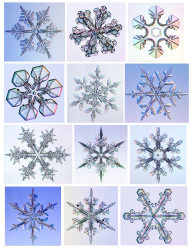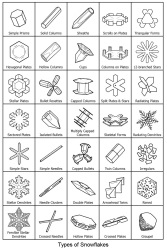|
|
Activities for Kids
... Fun with snowflakes ... |
|
This page contains some
snowflake-related things you can do with children. Some of the
activities are suitable for younger kids, and others might be adaptable
for the classroom. If you have any other ideas you would like to
share for this page, please send me an
e-mail.
|
|
Snowflake Cutouts |
 Cutting snowflakes out of paper is a
classic kids activity, and it's still a good one. Remember,
however, there are no eight-sided or four-sided snowflakes in nature, so
hold out for real six-sided crystals. For instructions on how to fold
the paper, click
here. Cutting snowflakes out of paper is a
classic kids activity, and it's still a good one. Remember,
however, there are no eight-sided or four-sided snowflakes in nature, so
hold out for real six-sided crystals. For instructions on how to fold
the paper, click
here.Rather than making random cuts in
the folded paper, try making snowflakes that look like the real thing!
That will add a challenge to the project, and require some thinking.
It's more difficult than it sounds! The picture at right has some real snow
crystals to try copying:
Click on the image for a larger jpeg image, or click
here for a .pdf file you can easily
print. Of course, if you don't want to use
real paper, you can also cut out snowflakes on the web at
SnowDays.
Here again, I recommend trying to create snowflakes that look like the
real thing. (Well, I find it entertaining....)
There's another amusing pseudo-snowflake maker
here. |
|
Snowflake Watching |
|
If you live in a cold climate, be
sure to go outside and look at what kinds of snowflakes are falling. It helps to have an inexpensive magnifier (see
Snowflake Watching for a buyers guide), but you can also see a lot
with the naked eye. Children can see snowflakes better than
adults, since their eyes can focus up close.
 Black
construction paper makes a good collecting surface, since it's easier to
see the crystals against a dark background. But you can also do
fine just looking at your sleeve. Black
construction paper makes a good collecting surface, since it's easier to
see the crystals against a dark background. But you can also do
fine just looking at your sleeve.
I recommend going outside with a
reference that shows you what kinds of crystals to look for.
Click on the table at right for a larger jpeg version, or click here
for a printable .pdf version. If you want more information, I
recommend my Field Guide to Snowflakes (see
Snowflake Books).
If the crystals look interesting,
have some contests to see who can find the different crystal types, who
can find the largest stellar crystals, etc. Remember, however
-- many snowfalls bring nothing but small, grainy snowflakes that look
essentially like white sand. On such days, there isn't much worth
looking at. If it's snowing, take a quick glance at the
crystals on your sleeve. If they look nice, then grab the kids
and go outside to give everyone a look! |
|
Collecting Snowflakes |
In addition to
looking at the falling snowflakes, you might also want to try making
some plastic snowflake replicas. This activity it too
difficult for small children, but the end result will be interesting for
all. Try the technique using Superglue described in
Snowflake Fossils. It will probably take several hours spread
over several weeks to get good results. First of all, you will
need a snowfall with good crystals - that alone may take some patience.
Second, it will take some trial and error to get decent replicas.
And finally, it takes a week just for the glue to dry in the cold.
Once you've mastered the technique, however, you can
use a magnifier (or microscope, if you have access to one) to look at
your replicas indoors, any time. It costs very little to try
this, and you may end up with a nice snowflake collection! |
|
Ice Spikes |
Everyone can try their hand at
making some ice spikes. All it takes is a dollar's worth of
distilled water, some ice cube trays, and a freezer. See
Ice Spikes for details. This is an easy overnight project that
makes a lasting impression. Ice spikes are bizarre, which makes
them fun to make!
|
|
